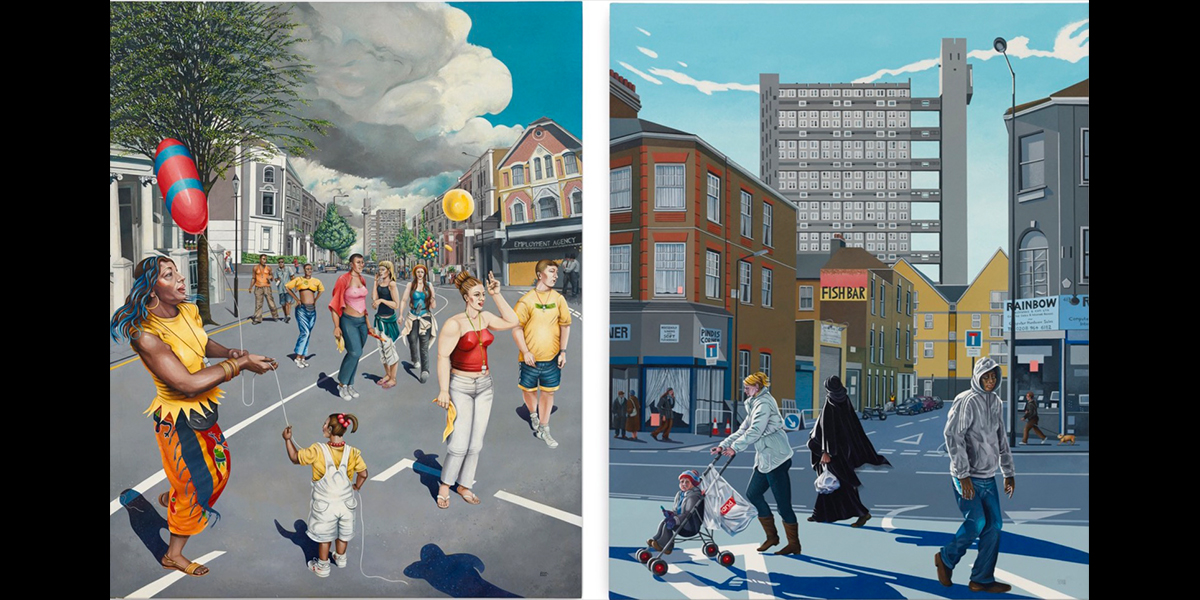Caroline Coon’s work focuses on her local neighbourhood in West London, the show brings together a selection of the artist’s ‘Urban Landscapes’ made over the past twenty-five years. Scenes of everyday life depicting roadways, social housing and canals, shoppers and pram-pushing mothers, are peppered with subtle allusions to the city’s darker underbelly.
Coon’s wider practice is dedicated to contesting binary notions of gender
Faithful depictions of Ladbroke Grove’s bustling community and architectural landmarks are juxtaposed with fantastical images of male and female commuters stripped of their clothing. Coon’s distinctive style is characterised by crisp-edged lines, bright colours and hyperrealism redolent of Paul Cadmus and Tamara de Lempicka.
Born in 1945 in London, Caroline Coon studied Fine Art at Central Saint Martins in the mid-1960s, opting for a medium and subject deemed unfashionable at the time – figurative painting. Coon was a trailblazer of London’s countercultural movement. She has campaigned for women’s rights since the 1960s; co-founded Release in 1967, a legal-advice agency for young people charged with the possession of drugs that continues today; and was central to London’s nascent punk scene, managing The Clash from 1978 to 1980.
In 2018, at the age of 73, Coon had her first ever solo show at The Gallery Liverpool entitled: ‘Caroline Coon: The Great Offender’. This was followed by a solo exhibition at TRAMPS in London (2019) curated by Peter Doig and Parinaz Magadassi. Her work recently featured in the group exhibition ‘Mixing It Up: Painting Today’ at the Hayward Gallery, London (2021) and will also be highlighted in ‘Women in Revolt!’ at Tate Britain, London in 2023. Two paintings by Coon were recently added to the permanent collection of Tate, London. She lives and works
Coon writes: “This neighbourhood has been my home for nearly sixty years. As I have grown old, the avenue of plane trees on Ladbroke Grove has grown magnificently tall. Even though I think I know each inch of territory – Regent’s Canal, the parks, secret mews and dark alleys – every so often I see something familiar in a new light. The privilege of stability I have enjoyed is in stark contrast to the flux and flow of enterprising people, refugees and migrants who have moved here escaping wars and searching for work. All the world seems to gather here contributing to a street life that zings with different languages and resourceful energy which can lift the human spirit even on the saddest day. Disasters have scarred this place. Homes were demolished to make way for the monstrous Westway motorway. Grenfell Tower tragically burned. But, with each crisis, the richly diverse multi-cultural community pulls together to do the hard work of political repair. Only the COVID-19 plague could stop Carnival! Otherwise, ever since 1966, despite establishment opposition, everyone who can put aside hardship and heartache joins in the parade, the spectacular August bank holiday bacchanalia of food, music and dancing. My enduring love of this place enables me to put LOVE into these urban landscape paintings.”
Inspired by feminism and the politics of sexual liberation, Coon’s wider practice is dedicated to contesting binary notions of gender and oppressive patriarchal values. Her work covers a variety of subjects including sex workers, beachgoers, intersex people, still lifes and football players. Coon’s paintings are united in their unwavering rebellion against the status quo.
Caroline Coon: Love of Place 23 September–5 November 2022 Stephen Friedman Gallery 25-28 Old Burlington Street London W1S 3AN

